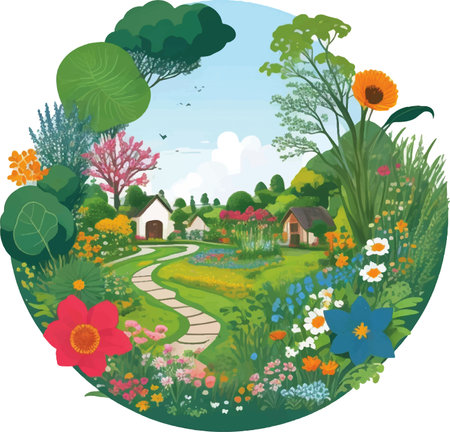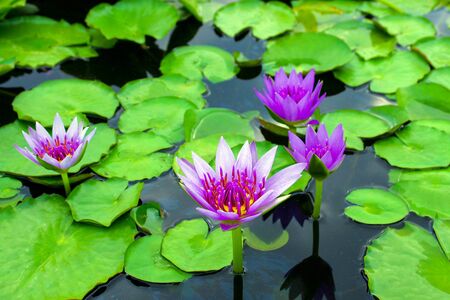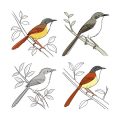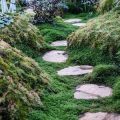1. Understanding the Benefits of a Wildlife Pond
Bringing a wildlife pond into your British garden is more than just a charming addition; it’s an invitation for local creatures to thrive and a wonderful opportunity for families to connect with nature. A well-designed pond supports native frogs, newts, dragonflies, and even hedgehogs, creating a bustling ecosystem right on your doorstep. For children, watching tadpoles wriggle or birds stop by for a drink sparks endless curiosity and fosters a deep appreciation for the world outside. These moments of discovery—like spotting the first lily pad bloom or hearing the evening chorus of frogs—turn your outdoor space into a living classroom filled with wonder. By nurturing this watery haven, you’re not just enhancing your garden’s beauty, but also inspiring little ones to ask questions, observe closely, and develop a lifelong respect for our wild neighbours.
2. Choosing the Ideal Spot in Your British Garden
Finding the perfect place for your wildlife-friendly garden pond is a delightful adventure, much like choosing the best spot for a family picnic—sunshine, shelter, and safety all come into play. In true British fashion, our ever-changing weather and unique garden layouts make this decision both practical and inspiring. Let’s explore the essential tips to help you select just the right spot that encourages thriving plants, happy children, and visiting wildlife.
Sunshine vs. Shelter: Striking the Right Balance
Ponds thrive when they receive gentle morning sun but are sheltered from harsh afternoon rays. Aim for a location that enjoys 4-6 hours of sunlight daily—enough to support aquatic plant growth without overheating or encouraging excessive algae. Avoid placing your pond directly under trees, as falling leaves can quickly clog your water and make maintenance tricky.
| Location Feature | Benefits | Considerations |
|---|---|---|
| Partial Sunlight (East/Southeast) | Promotes healthy plant life; attracts dragonflies and butterflies | Avoids overheating in summer; prevents algae blooms |
| Sheltered from Wind (Near Fences/Hedges) | Protects pond surface; supports nesting birds and insects | Avoid deep shade; ensure some light still reaches water |
| Away from Overhanging Trees | Reduces debris in pond; easier maintenance | Provides space for marginal plants to flourish |
Family Safety: A Top Priority
If little ones love exploring your garden, safety is paramount. Choose a spot where you can easily supervise the pond from your home or favourite garden seating area. Consider installing gentle slopes rather than steep edges, and use decorative fencing or low hedging to create a natural barrier—allowing children to observe wildlife safely while still learning from nature’s wonders.
Plant Growth Considerations: Nurturing Life Together
Plants are the heart of any wildlife pond. Opt for a position where your chosen aquatic and marginal plants will have enough sunlight to bloom, but not so much that they wilt during hot spells. Remember, native British species like water forget-me-nots and marsh marigolds particularly enjoy dappled light and moist soil at the pond’s edge.
Top Tips for British Gardens:
- Check Drainage: Avoid sites prone to waterlogging or standing water after rain—this helps maintain healthy pond conditions year-round.
- Accessibility: Leave space around your pond for planting, maintenance, and family wildlife-watching adventures.
- Away from Utilities: Steer clear of underground pipes or cables when digging—always check before you start!
- Viewpoints: Place your pond where it can be enjoyed from indoors on rainy days—a classic British pleasure.
The right location sets the stage for a thriving wildlife haven where both plants and people flourish side by side. With a bit of thoughtful planning inspired by nature’s rhythms, you’ll soon discover your garden’s hidden potential—and perhaps inspire young gardeners at home to dream up their own wild spaces too.

3. Planning the Pond: Size, Shape, and Features
When designing a wildlife-friendly pond for your British family garden, thoughtful planning is essential to create a welcoming and safe haven for both children and nature. Choosing the right size is a wonderful opportunity to involve everyone—remember, even a small pond can become a thriving ecosystem! Consider starting with a modest footprint, such as 1–2 metres across, which fits well in most gardens and provides enough space for wildlife without taking over your green sanctuary.
The shape of your pond can be inspired by the gentle curves found in nature—think of how water meanders through a woodland or how puddles form after rain. Irregular edges not only look more natural but also offer more nooks for plants and creatures. Avoid steep, straight sides; instead, design gentle slopes that allow frogs, hedgehogs, and adventurous little ones to approach the water safely. Shallow margins are especially important—they encourage birds to bathe, insects to drink, and children to observe up close without risk.
Including features like planting shelves (shallow ledges around the edge) allows you to grow native aquatic plants such as water forget-me-nots or marsh marigolds. These shelves provide stepping stones for wildlife and colourful discovery zones for curious young minds. A mix of depths—some areas no deeper than 20–30cm—means tadpoles and dragonfly larvae have places to thrive while keeping the pond accessible for family exploration.
Remember to leave one side gently sloping and free from barriers so that both animals and children can come and go easily. Adding stones or logs along the edge gives frogs shelter and creates natural stepping points for small feet. By carefully planning your pond’s size, shape, and features with family interaction in mind, you’ll nurture a shared space where learning happens hand-in-hand with nature—right at home in your British garden.
4. Selecting Native Plants and Creating Natural Edges
One of the most rewarding ways to make your garden pond a haven for wildlife is by choosing native aquatic plants and designing naturalistic pond edges. When you fill your pond with British native plants, you invite pollinators, provide shelter for frogs and newts, and create a miniature ecosystem that’s as vibrant as any countryside stream. Let’s explore how thoughtful planting choices can transform your pond into a thriving wildlife sanctuary.
Recommended British Native Aquatic Plants
Native aquatic plants not only thrive in the local climate but also offer food, oxygen, and cover for various pond dwellers. Here’s a table of recommended species, along with their key benefits:
| Plant Name | Type | Main Benefits |
|---|---|---|
| Water Forget-me-not (Myosotis scorpioides) |
Marginal | Attracts pollinators; offers shelter to tadpoles and insects |
| Marsh Marigold (Caltha palustris) |
Marginal | Early nectar source for bees; bright spring flowers |
| Hornwort (Ceratophyllum demersum) |
Submerged | Oxygenates water; provides hiding places for small creatures |
| Water Mint (Mentha aquatica) |
Marginal/Shallow Water | Nectar for butterflies and bees; aromatic foliage deters pests |
| Yellow Flag Iris (Iris pseudacorus) |
Marginal | Shelter for amphibians; striking vertical accent at waters edge |
| Bogbean (Menyanthes trifoliata) |
Floating/Edge | Creeping habit stabilises banks; white flowers attract pollinators |
| Lesser Spearwort (Ranunculus flammula) |
Marginal/Shallow Water | Tiny yellow flowers attract hoverflies; provides dense cover |
Natural Planting Ideas to Support Pollinators and Pond Life
When planting around your pond, think layers: tall irises at the back, creeping bogbean along the edge, and floating leaves of water lilies or frogbit on the surface. This variety creates both sun-dappled open water for dragonflies and shady retreats for shy newts or tadpoles.
The Importance of Natural Edges
A gently sloping or “beach” style edge allows frogs, hedgehogs, and other visitors easy access in and out of the pond. Avoid harsh barriers like plastic liners exposed above water level—instead, use pebbles, logs, or turf to soften the boundary between land and water. Planting thickly along these edges with native grasses or wildflowers provides safe corridors for young amphibians venturing from the pond.
Pond-Edge Planting Inspiration:
- Damp-loving wildflowers: Ragged Robin (Lychnis flos-cuculi) and Meadowsweet (Filipendula ulmaria) bring delicate colour while supporting bees and butterflies.
- Mossy logs: Place partially submerged logs or stones to encourage moss growth—these offer hiding spots for insects and perching sites for birds.
- Mixed heights: Combine low-growing marsh plants with taller reeds or sedges to create a layered habitat structure.
- No-mow strips: Leave grass unmown near one side of the pond to act as a wildlife corridor from your garden into the watery world.
Selecting native plants and creating gentle, natural edges will not only support British wildlife but also foster enchanting parent-child moments—spotting dragonflies skimming over forget-me-nots or watching newts slip between iris stems is pure garden magic that brings nature closer to home.
5. Welcoming and Supporting British Wildlife
A wildlife-friendly garden pond becomes a living classroom for both adults and children, offering the perfect space to connect with nature while making a real difference to local biodiversity. To attract a delightful cast of British wildlife—frogs, newts, dragonflies, and birds—thoughtful planning is key.
Encouraging Amphibians: Frogs and Newts
Amphibians are among the first visitors to a well-designed pond. To make them feel at home, ensure your pond has gently sloping sides or shallow zones where frogs and newts can easily enter and exit. Avoid introducing fish, as they may eat amphibian eggs and larvae. Surround your pond with native plants, stones, and logs, providing shelter and cool hiding spots—perfect for curious little hands to gently explore during family spot-and-learn sessions.
Dragonflies: Jewels of the Pond
Dragonflies love ponds with clear water, plenty of sun, and tall aquatic plants like iris or rushes for perching and egg-laying. Encourage your children to watch for the magical moment when dragonfly nymphs emerge from the water and transform into adults—a wonderful lesson in patience and metamorphosis inspired by the rhythms of British gardens.
Inviting Birds for a Splash and Sip
Birds are drawn to water for drinking and bathing. Adding flat stones at the pond’s edge gives robins, blackbirds, and other favourites a safe place to perch. Plant berry-rich shrubs nearby to offer food throughout the seasons. Children will love keeping a simple bird-watching diary as different feathered visitors arrive.
Family Spot-and-Learn Activities
The magic really happens when you invite children to join in the adventure. Try these activities:
- Pond Dipping: Use nets or jars to gently observe pond creatures up close before returning them safely.
- Wildlife Logs: Keep a notebook together to record sightings of tadpoles, newts, damselflies, or visiting birds as your pond matures through the seasons.
- Nature Sketching: Bring out pencils and encourage sketching what you see—from rippling water lilies to sunbathing frogs.
A Garden That Grows With Your Family
A British wildlife-friendly pond is more than just water—it’s a place where young minds blossom alongside wild creatures. With every visit, you nurture a deeper sense of wonder, responsibility, and connection to nature right in your own back garden.
6. Maintaining a Healthy Pond with Minimal Fuss
If you dream of a wildlife-friendly pond that stays healthy without endless chores, you’re not alone! The good news is, British families can work together to keep their garden pond thriving with just a few simple, seasonal tasks—little moments that double as quality time outdoors and gentle learning for young nature-lovers.
Spring: A Fresh Start
As the days grow longer, sweep away fallen leaves and any debris from the water surface using a small net. Children love helping with this gentle “pond clean-up,” and it’s a great way to spot returning frogs or newts. Check pond edges for any winter damage and top up water levels with rainwater if needed, avoiding tap water which can disrupt pond chemistry.
Summer: Mindful Maintenance
Warmer weather brings a flurry of wildlife activity. Encourage children to observe visiting dragonflies and listen for croaking frogs. To prevent green water, remove excess duckweed or blanket weed by hand—perhaps even turn it into a friendly family competition! Top up water with collected rainwater during dry spells, and shade part of the pond with floating plants or nearby pots to help keep temperatures cool for aquatic residents.
Autumn: Gentle Tidying
Falling leaves are beautiful but can overload your pond if left unchecked. Skim off leaves regularly and trim back overgrown marginal plants. Involve little ones in gathering plant trimmings—they’ll enjoy feeling helpful while learning about seasonal changes in the garden.
Winter: Quiet Care
Your pond needs less attention now, but you can teach children to break ice gently (with a saucepan of hot water placed on the surface) so wildlife still gets oxygen. Avoid disturbing hibernating creatures and leave some vegetation standing for shelter.
Keep It Wild, Keep It Simple
Letting your pond remain a little wild is often best for wildlife—resist the urge to make it too tidy! Each small act, whether skimming leaves or topping up rainwater, helps create a haven where British garden creatures can flourish. Through these easy, low-impact tasks done together, your family nurtures both the pond’s eco-system and each other’s love for nature.
7. Safety and Family Participation in Pond Life
Practical Steps for a Safe Garden Pond
When creating a wildlife-friendly garden pond, safety comes first, especially for families with young children or curious pets. Consider installing a sturdy mesh cover just beneath the water’s surface—strong enough to support a child’s weight but subtle enough not to hinder wildlife movement. Position pond edges with gentle slopes rather than steep drops, using cobbles or planting shelves to help small animals climb out easily. Remember, clear signage and open conversations about pond safety set ground rules for everyone enjoying the garden.
Fostering Respect for Nature
Transform your pond into an outdoor classroom by encouraging children to observe and respect wildlife from an appropriate distance. Equip them with magnifying glasses or simple identification guides tailored for British flora and fauna, fostering curiosity without disturbing delicate habitats. Remind young ones never to catch or relocate amphibians, tadpoles, or insects—nature thrives best when left undisturbed.
Seasonal Changes: A Year-Round Adventure
Your pond is alive with seasonal wonders. In spring, spot frogspawn and listen for croaking; come summer, dragonflies dart above lily pads. Autumn brings falling leaves and new colours, while winter reveals icy patterns and resting frogs tucked beneath the water’s surface. Encourage children to keep a nature diary or sketchbook, recording each discovery as the seasons shift—a gentle way to nurture patience and wonder for the natural world.
Family Rituals and Shared Memories
Make regular pond visits part of your family rhythm—whether it’s weekend wildlife-spotting or twilight frog-counting sessions. These shared experiences cultivate lasting memories and instil values of stewardship and care for our British landscapes. Involving children in tasks such as topping up water levels with rainwater or gently removing windblown litter also fosters responsibility and teamwork.
By prioritising safety, nurturing respect for wildlife, and celebrating the ever-changing tapestry of life within your pond, you create not only a haven for nature but also a cherished space where family bonds grow alongside native plants and creatures.


